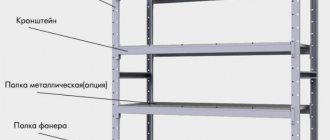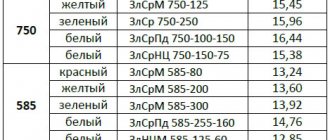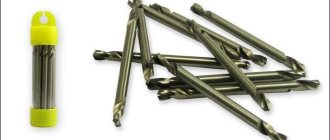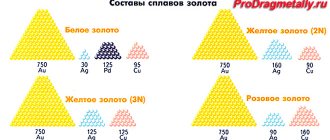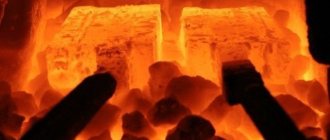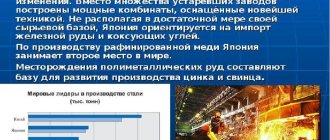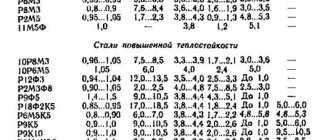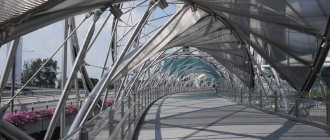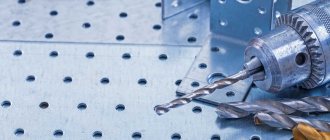03/18/2020 Author: VT-METALL
Issues discussed in the material:
- Colors for metal and other products according to the RAL catalog
- Colors of metal products: metallic and pearl
- The best paints for metal
- Paints that can and should be used to paint rust
- Some tips for choosing paint colors for metal products
The colors of metal products can be very different. The main thing is that they correspond to the overall design of the room or building. And there is one problem. For example, if a country house was built separately, and a fence around it was erected after some time, then it will be quite difficult to choose the color.
But there is still a solution. To choose the most suitable shade, you will have to refer to the RAL catalog. Not everyone knows what it is, but we will try to help.
Directory: Steel marking
Steel marking is done with indelible paint, regardless of the steel group and degree of deoxidation.
By agreement of the parties, paint marking is not performed. Letters and numbers for steel: Grades of carbon steel of ordinary quality are designated by the letters St and number (StO, St1, StZ, etc.). High-quality carbon steels are marked with two-digit numbers showing the average carbon content in hundredths of a percent: 05; 08; 10; 25; 40, etc. The letter G in the steel grade indicates a high Mn content (14G; 18G, etc.). Automatic steels are marked with the letter A (A12, A30, etc.). Carbon tool steels are marked with the letter U (U8; U10; U12, etc. Here the numbers indicate the steel content in tenths of a percent).
The designation of the alloy steel grade consists of letters indicating which components are included in its composition and numbers characterizing their average content: A - nitrogen Y - aluminum P - boron F - vanadium B - tungsten K - cobalt C - silicon D - manganese D – copper M – molybdenum N – nickel B – niobium C – selenium T – titanium U – carbon P – phosphorus X – chromium C – zirconium
The first digits of the grade indicate the average carbon content in steel (in hundredths of a percent for structural steels and tenths of a percent for tool and stainless steels). Then the letter indicates the alloying element. The numbers following the letter indicate its average content in whole units. When the alloying element content is less than 1.5%, numbers are not placed after the corresponding letter. The letter A at the end of the brand designation indicates that the steel is high quality. Letter Ш – especially high quality. Ordinary quality steel St0; VSt0, BSt0 – Red and green St1, VSt1kp – Yellow and black St2, VSt2kp – Yellow StZ, VStZkp, VStZ, BStZkp, BStZ – Red St4, VSt4kp, VSt4, BSt4kp, BSt4 – Black St5, VSt5 – Green St6 – Blue
Quality carbon steel 08, 10, 15, 20 – White 25, 30, 35, 40 – White and yellow 45, 50, 55, 60 – White and brown
Alloy structural steel Chrome - Green and yellow Chrome-molybdenum - Green and purple Chrome-vanadium - Green and black Manganese - Brown and blue Chrome-manganese - Blue and black Chrome-silicon - Blue and red Chrome-silicon-manganese - Red and purple Nickel-molybdenum - Yellow and purple Chrome-nickel - Yellow and black Chrome ony-nickel-molybdenum – Purple and black Chrome-aluminium – Aluminum
Corrosion-resistant steel Chrome - Aluminum and black Chrome-nickel - Aluminum and red Chrome-titanium - Aluminum and yellow Chrome-nickel-silicon - Aluminum and green Chrome-nickel-titanium - Aluminum and blue Chrome-nickel-niobium - Aluminum and white Chrome-manganese-nickel - Aluminum and brown Chrome-nickel-molybdenum Ethane – Aluminum and Violet
High speed steel P18 – Bronze and red P9 – Bronze
Hard sintered alloys VK2 – Black with a white stripe VKZ-M – Black with an orange stripe VK4 – Orange VK6 – Blue VK6-M – Blue with a white stripe VK6-V – Purple VK8 – Red VK8-V – Red with a blue stripe VK10 – Red with white stripe VK15 – White T15K6 – Green T30K4 – Blue
Steel what color is this
All shades of gray - so mysterious and elegant.
In the true sense of the word, gray is not a real color. Gray is black diluted with white and its shades can vary from charcoal to light pearl. Gray is the color of intelligence, it is thoughtful and contemplative. Since ancient times, it has been used as a symbol of renunciation and self-absorption.
Ambiguities of Gray
Gray color has many faces. Some of its shades can cause boredom and be invisible. In connection with this property, such phrases as “gray mouse” (this is the name for a small, inconspicuous person), or “gray cardinal” (this is the name for an influential person who acts behind the scenes) arose. When they say “lead a gray life,” they mean a boring life the average person.
On the other hand, gray color is inextricably linked with silver and is considered a symbol of calm and serenity; it brings wisdom and peace of mind to a person. The silver shades of gray used in product packaging convey luxury and quality.
Dark gray shades of gray convey the strength, longevity and tranquility of the rocks to the surrounding space. Medium shades of gray have dignity and conservatism. Light gray shades are innocent and light. They express freedom and peace.
Gray is nature's ideal neutral tone. Designers use it as a background because it goes perfectly with any other colors. Gray is unobtrusive and noble and allows other colors to play leading roles.
Shades of gray
Gray can be a completely neutral color, or it can take on cool or warm shades depending on the environment or small additions of other colors. Some shades of gray are very famous and popular and have beautiful names.
French gray (originates from paintings in gray tones (grisaille) and panoramic wallpapers of Jean Zubert (early 19th century), painted with gray paint)
Abdel-Kerim's beard color
Silver (silver) - metallic color
Slate gray color
The gray color is also graphite. Dark gray color with a bluish-whitish tint.
Feldgrau (German feldgrau, field gray) is the main color of the field uniform of the German army from 1907 and mainly until 1945. Feldgrau represents a spectrum of color shades from gray to brown. In the classical sense, feldgrau is a gray color with a predominance of green pigment.
Fainted frog color
Gray asparagus color
Gray color in the interior
Gray is called a “design workhorse” because it pairs perfectly with any other color. Gray is ideal for the background and can be used to prevent design mistakes. It will soften flashy colors and emphasize the beauty of clear shades. Gray color is very suitable for men's offices and for interiors in a minimalist style.
When creating gray interiors, you need to take into account some features. We must remember that monochrome gray looks too monotonous, so it is important to use different textures, processing forms and shades, and be sure to bring additional colors into the room, at least in small quantities. Upholstered furniture in gray often looks more expensive than its colored counterparts, but to highlight the depth and elegance of gray, it's good to add a pile of bright pillows.
Author: based on the book “The Tao of Color” by Leatrice Iceman Article publication date: December 2014 Please respect copyright. Please follow the terms and conditions for reprinting materials.
Share with friends: steel color is: See what “steel color” is in other dictionaries:
STEEL - STEEL, steel, steel. 1. Made of steel. Steel feathers. Steel knife. Steel products. 2. adj. by value related to the production and marketing of steel. Steel Trust. Steel cartel. 3. Similar in color to steel, light gray with a tint.… … Ushakov’s Explanatory Dictionary
Eye color - Blue eye Eye color is a characteristic determined by the pigmentation of the iris. Contents... Wikipedia
Sea Green - Blue (#00BFFF) Light Blue RGB Color Coordinates HEX #00BFFF (r, g, b) (0, 191, 255) (c, m, y, k) ... Wikipedia
steel - adj. used compare often 1. Something made of steel is called steel. Steel rope. | Steel rails. | Steel structures, floors. 2. Silver-gray color of something is called steel. The steel surface of the sea. | The car is steel-colored. | ... Dmitriev's Explanatory Dictionary
Steel - adj. 1. ratio with noun steel, associated with it 2. Characteristic of steel, characteristic of it. Ott. trans. Unyielding, unshakable, steadfast. Ott. trans. Firm, confident (about voice). Ott. trans. Hard, cold, unfriendly (about the look). 3.… …Modern explanatory dictionary of the Russian language by Efremova
steel - oh, oh. 1. to Steel. C. ingot. Oh ring. C. cable. From the rails. Designs. 2. Having the color of steel; silver gray. From the surface of the sea. Steel color dress. 3. Strong, strong; unshakable, unyielding. S y muscles. Nerves. From ... Encyclopedic Dictionary
steel - post office, o/e. 1) to steel Steel ingot. Oh ring. Steel rope. From the rails. Designs. 2) Having the color of steel; silver gray ... Dictionary of many expressions
Marengo (color) - This term has other meanings, see Marengo. Marengo Color coordinates HEX #4C5866 RGB¹ (r, g, b) (76, 88, 102) ... Wikipedia
Blue color - Blue Color coordinates HEX #0000FF RGB¹ (r, g, b) (0, 0, 255) CMYK² ... Wikipedia
Gray color - Gray Color coordinates HEX #79a0c1 RGB¹ (r, g, b) (121, 160, 193) CMYK² ... Wikipedia
Cyan color - Cyan (#00BFFF) Cyan RGB color coordinates HEX #00BFFF (r, g, b) (0, 191, 255) (c, m, y, k) ... Wikipedia
Names of colors and shades
The palette of colors and shades used by artists and designers is simply amazing. And thanks to changing trends, fashionistas around the world are just as diligently studying color schemes, just like fashion magazines. Thus, upon closer examination, the familiar yellow color is divided into: mustard, gold, lemon, saffron, canary, pear, corn, chartreuse, spring bud, dahlia yellow, tangerine, antique gold... and this is not a complete list of its shades! How to understand the existing variety of shades, and most importantly - is it necessary at all? After all, the perception of color is purely subjective, it is influenced not only by cultural factors, but also by physiological ones (the ability of the eye to distinguish nuances of color varies from person to person by nature). Additionally, a shade may appear warmer or cooler depending on the colors around it.
In this article we will talk about colors and shades, their names, and also tell you about the intricacies of combining different shades of color.
Cool colors and shades
To clearly demonstrate the continuity of transitions of colors and shades, a color wheel is used. It is based on three colors: red, yellow and blue. When mixing these colors with each other, we get intermediate colors: orange, green and purple. All other shades are obtained by mixing these colors with each other, as well as with black and white.
There are three main ways to display the color wheel, although they are essentially the same thing.
The basis of cool colors is a bluish undertone. If, when looking at a color, you can imagine that blue, gray or blue shines through it, this shade is cool.
Cool shades are:
- Dark red;
- cochineal;
- scarlet;
- alizarin;
- crimson;
- cardinal;
- magenta;
- eggplant;
- wisteria;
- citric;
- taup;
- jade;
- aquamarine;
- indigo;
- Prussian blue;
- gridperleft;
- anthracite;
- Marengo.
Warm shades of colors
It should be borne in mind that the perception of many shades depends on the colors nearby. The expression “everything is known by comparison” is very relevant for color temperature. Even among the shades of the same temperature scale, you can find warmer and cooler shades. The easiest way to compare shades is with a neutral (for example, white). Warm shades of color will have a “glow” of yellow, red or pink.
These include:
- cinnabar;
- Titian;
- orchid;
- tangerine;
- mustard;
- pear;
- saffron;
- golden;
- chocolate;
- ocher;
- vanilla;
- olive;
- lavender;
- amethyst.
In addition, there are also so-called neutral colors:
- silver;
- wet asphalt;
- thistle;
- green moss;
- green mint (minty).
For the correct combination of colors and shades, you should learn to distinguish warm tones from cold ones. There are three ways to create color compositions.
For the first of them, several shades of the same color are chosen. This method is suitable for creating discreet, elegant ensembles.
For the second, adjacent colors (located next to each other on the color wheel) are combined.
The third method uses complementary colors (located on opposite parts of the color wheel). In this way, the most catchy, effective compositions are obtained.
As you can see, it is still worth learning to distinguish between warm and cold colors and shades, but it is not at all necessary to memorize the names of each of the dozens of tones and halftones. Even if you are a stylist or designer, it will be easier to carry several color palettes with names with you than to constantly keep colors in memory. Plus, it's much easier to show an example of color than to try to explain the difference between, for example, Indian red, salmon and light coral.
Yellow color can lift your spirits and make your image bright and sunny in summer. But, like any other color, it has a lot of shades - both warm and cold, each of which has subtleties and nuances in combination with other colors.
Shades of pink are considered the most feminine, delicate and romantic. At the same time, bright pink color looks very sexy, bold, and in some cases even defiant. It all depends on the selected shade and its combination with other colors.
Three primary colors - blue, red and yellow - when mixed, create an endless variety of shades and color nuances. Even the most brilliant artist cannot remember the full palette of colors and shades, but learning to distinguish the main ones is the responsibility of every self-respecting fashionista.
Many people associate the classic brown color with school uniforms, so it seems boring. But if you use one of its shades in your image that suits your color type, you can highlight your appearance and create a stylish look.
- Colors of electrical wiring As follows from the rules of electrical installations, the colors of electrical wiring must make it possible to recognize it. Necessary…
- Brown kitchen: what does brown go with in the interior? A brown kitchen goes perfectly with white - you get a certain balance between “monumental” and “light”...
- Yellow kitchen: what color to choose for contrast Whatever color of the kitchen you choose, nothing will be more contrasting and cheerful than yellowKitchen design…
- How to choose the grout color for tiles? What to choose: the color of the tiles or contrast? Spectacular contrasting combinations Is colorless grout universal? Adviсe…
Marking of rolled metal
Marking of rolled metal products is regulated by GOST 7566-94. However, during the construction process, not everyone wants to understand GOST standards. In addition, all markings, for example, of rebar or steel angles, are listed in the price list. And then you saw strange abbreviations there. To understand which rolled metal product is suitable in each specific case, it is enough to know the rules for reading labeling symbols.
For example, to fence an area with a fence made of corrugated sheets, you must purchase a metal profile of a certain marking. This type of rolled metal product is marked in the form of a set of numbers and letters: for example, 0.7x2000x3000 C9. This combination of characters carries the following information:
- 0.7 mm – thickness;
- 2000 mm – width;
- 3000 mm – length.
Now we can conclude that the profile sheet will have a size of 2 * 3 m and a thickness of 7 mm. The letter indicates the application: C – wall, N – roofing, and NS – mixed type, which is used for various purposes. Any metal warehouse is required to advise you on this matter.
However, you must figure it out yourself so that when purchasing products in the future, you can check whether the appropriate rolled metal alloy was delivered and whether it is marked according to accepted standards. Rolled metal is marked depending on its supply to the market: internal or external.
Symbols of the main elements in grades of metals and alloys
| Element | Symbol | Symbols of alloying elements | Density, g/cm3 |
| Nitrogen | N | A | 1,25 |
| Aluminum | A.I. | YU | 2,698 |
| Barium | Ba | — | 3,61 |
| Beryllium | Be | L | 1,86 |
| Bor | B | R | 2,33 |
| Vanadium | V | F | 6,12 |
| Bismuth | Bi | In and | 9,79 |
| Tungsten | W | IN | 19,27 |
| Gadolinium | Gg | — | 7,886 |
| Gallium | Ga | Gl | 5,91 |
| Hafnium | Hf | — | 13,36 |
| Germanium | Ge | — | 19,3 |
| Holmium | Ho | — | 8,799 |
| Dysprosium | Dy | — | 8,559 |
| Europium | Eu | — | 5,24 |
| Iron | Fe | — | 7,87 |
| Gold | Au | — | 19,32 |
| Indium | In | — | 7,3 |
| Iridium | Ir | AND | 22,4 |
| Ytterbium | Yb | — | 6,959 |
| Yttrium | Y | — | 4,472 |
| Cadmium | Cd | Kd | 8,642 |
| Cobalt | Co | TO | 8,85 |
| Silicon | Si | C | 2,326 |
| Lanthanum | La | — | 6,162 |
| Lithium | Li | — | 0,534 |
| Lutetium | Lu | — | 9,849 |
| Magnesium | Mg | — | 1,741 |
| Manganese | Mn | G | 7,43 |
| Copper | Cu | D | 8,96 |
| Molybdenum | Mo | M | 10,22 |
| Neodymium | Nd | — | 7,007 |
| Nickel | Ni | N | 8,91 |
| Niobium | Nb | B | 8,55 |
| Tin | Sn | — | 7,29 |
| Osmium | Os | — | 22,48 |
| Palladium | Pd | — | 12,1 |
| Platinum | Pt | — | 21 |
| Praseodymium | Pr | — | 6,769 |
| Rhenium | Re | — | 21,04 |
| Rhodium | Rh | — | 12,5 |
| Mercury | Hg | — | 13,5 |
| Ruthenium | Ru | 12,3 | |
| Samarium | Sm | — | 7,53 |
| Lead | Pb | — | 11,337 |
| Selenium | Se | E | 4,792 |
| Silver | Ag | — | 10,5 |
| Scandium | Sc | — | 2,99 |
| Antimony | Sb | — | 6,69 |
| Thallium | Tl | — | 11,85 |
| Tantalum | Ta | — | 16,6 |
| Tellurium | Te | — | 6,25 |
| Terbium | Tb | — | 8,253 |
| Titanium | Ti | T | 4,505 |
| Thulium | Tu | — | 9,318 |
| Carbon | C | U | 2,2 |
| Phosphorus | P | P | 1,83 |
| Chromium | Cr | X | 7,2 |
| Cerium | Ce | — | 6,768 |
| Zinc | Zn | — | 7,13 |
| Zirconium | Zr | C | 6,5 |
| Erbium | Er | — | 9,062 |
Labels for marking rolled metal products
Labels must be firmly attached and easily visible. The material used for manufacturing is reliable and wear-resistant, so that during transportation and unloading they are not damaged or come off. Sometimes, for safety, labels are placed in special pockets.
When packing rolled metal into bundles, markings are placed in 2 places:
- the top sheet or strip of each bundle;
- marking card or label attached to the pack's binding.
When auto-marking thick and strip metal products, the side edge of the top sheet or strip of each bundle can be branded. On the sheets, the marking area is outlined using paint, bitumen or colored varnish. If the customer so requests, the markings are highlighted in a contrasting color, and the labels are perforated 10 mm from the edge for fastening with wire on all types of metal products.
Marking of rolled products in packs or without packaging if the size exceeds 3 cm and thickness exceeds 4 mm must contain:
- Name of the company;
- steel grade;
- Heat number;
- Batch number;
- all sizes.
The marking on the label, the end of the roll or the edge of the metal sheet contains the company name, steel grade, heat number, batch number, all sizes, group or strength class, weight. For reliability and clarity of marking, the label can be metal, wood, plastic or moisture-resistant film; their area must be at least 24 cm2, and the letters must have a height of 5-20 mm and a width of 3-12 mm.
Sometimes it is allowed to deviate from the specified font size when marking with paint. It can reach 1 m in height and 7 cm in width; on rods with a diameter of less than 6 cm and strips with a width of less than 5 cm it can be reduced to 2-4 mm.
The consumer may request additional marking with colored paint; for rolled metal made of mild steel, marking with a longitudinal stripe; for rolled metal made of mild steel, a transverse stripe; marking can occur at a specified font depth. Transport marking is regulated by GOST 14192.
Magnesium and alloys: marking and description
Technical magnesium does not have the best properties, so it is not used as a construction material. But magnesium alloys, in accordance with standards, are divided into casting and wrought.
In accordance with GOST, foundries are marked as “ML”, as well as with a number indicating their conditional number. In some models, after the numbers there are the following lowercase letter designations:
- “pch” - increased purity;
- “he” is a general purpose material.
And deformable magnesium alloys are marked with the letters “MA”, as well as a number corresponding to the conditional number of the material. After the number there may also be the designation “pch”.
Magnesium materials have an excellent combination of properties such as:
- low density;
- high corrosion resistance;
- relatively high strength;
- good technological qualities.
Magnesium alloys are used to produce parts of simple and complex shapes that are highly resistant to corrosion. For example:
- fittings;
- neck;
- pump housings;
- gasoline tanks;
- brake wheel drums;
- steering wheels;
- farms, etc.
Marking of rolled metal for the foreign market
Rolled metal products supplied abroad are marked in Russian when transported to SMGS countries, and in English for other foreign countries.
Marking can be applied to:
- 2 ends;
- one longitudinal side (if it is impossible to apply to the ends);
- longitudinal side and end (rolled sheets in packages);
- top sheet of the pack (if there is packaging);
- each sheet (rolled sheet metal without packaging);
- marking card no less than 200x290 mm;
- steel label for export (if it is not technically possible to apply markings to the marking card or the rolled metal itself).
Labels are hung in the following order: one label per pack up to 6 m, coil, roll, wire rod; two labels are hung on a pack larger than 6 m, a bunch of skeins, a stack of rolls. The standards for labels for export differ from the requirements for labels that mark steel products for domestic sale.
Export labels must have a size of at least 80x120 mm and an aspect ratio of 1/1.5 and be made of tinplate, galvanized thin-sheet anti-corrosion metal, moisture-resistant film, which is applied to a solid metal base or some other dense material.
The export label must contain the following information about the metal product: name of the manufacturer's company, exporter's company, contract specification, country of destination, all dimensions, steel grade, group and strength class, heat and batch number, net and gross weight in kg, place of batch fraction.
Colors for metal and other products according to the RAL catalog
At the beginning of the twentieth century, when industry was actively developing, in particular the production of paints and varnishes, scientists came to the conclusion that it was necessary to standardize colors. This is how the RAL catalog appeared, used to this day in construction, design and production.
RAL is the color standard that is used most often. It is a code that has the RAL prefix and several numbers. This pattern is widely used in most industries where precise color is required for the manufacture of products.
The first of the RAL standards was developed in Germany. It had only 40 colors. And currently the RAL Institute is working on creating more and more new color options, according to the needs of manufacturers. Today there are already several thousand shades.
The most popular now is the RAL CLASSIC catalog, which has 213 colors. Of these: 2 metal, 15 pearl and 5 luminescent. The encoding in RAL CLASSIC is a designation of the RAL standard and a number with four digits, the first of which is the shade number from 1 to 9. In this case, 1 is yellow, 2 is orange, 3 is red, 4 is violet, 5 is blue, 6 – green, 7 – gray, 8 – brown, 9 – black, white. The other three numbers reveal the shade of the first color. All codes have names in Russian, for example, RAL 1037 is defined as “sunny yellow”. However, the name does not fully reveal the shade and it is more correct to remember only the numbers.
The most common catalog, as already mentioned, is RAL Classic. In addition to this, the following are used:
- RAL Design, consisting of 1,625 colors. Each has a seven-digit numbering that reveals the color, its saturation and brightness.
- RAL Effect, including 490 colors. It includes 70 metallic shades and 420 matte shades. All of them are used for water-dispersion paints in industrial production conditions.
- RAL Plastics - this catalog is used for coding plastic products.
When choosing a coating, you need to pay attention to its texture, and not just the shade or color. However, this applies mainly to industrial powder coating.
If earlier the paint could be matte or glossy, now a slightly different classification of textures is used. The ISO 2813 standard is responsible for it, where the main indicator is the percentage of glossy surface:
| For gloss% | Invoice type |
| 10–19 | Matte |
| 20–49 | Semi-matte |
| 50–79 | Semi-gloss |
| 80–100 | Glossy |
Before choosing one option or another, it is necessary to understand how the product will be used in the future. When choosing a coating for metal structures, you should pay attention to the recommendations of specialists.
Semi-gloss and gloss paints have excellent decorative properties. However, they can cause discomfort due to their shine, reflecting the rays of the sun or lamps.
There is another disadvantage of such surfaces - they require constant maintenance. Smooth and shiny, they make any dirt very noticeable. This especially applies to wet fingerprints.
Recommended reading
- Cutting copper with a laser: advantages and disadvantages of technology
- Types of metal cutting: industrial applications
- Metalworking according to drawings: convenient and profitable
When light hits a matte or semi-matte surface, it is scattered. That is why products with such a coating look more discreet. In addition, they get dirty less, which makes the choice of such paints more practical.
In addition to uniform textures, other decorative coatings have been developed:
- Shagreen. It has a fairly coarse texture that resembles the peel of an orange. It has high wear resistance and perfectly masks surface defects.
- Antique. The coating imitates old noble metal. Metallic paints are often used for this purpose. Such coatings are highly decorative.
- Moire. The surface of the product becomes velvety with small grains. Extremely resistant to scratches and other minor damage.
- Hammer effect. The coating imitates hammered metal, hides product unevenness well, withstands environmental influences, and is easy to clean.
In addition to the above, other textures are also used to impart decorative properties to metal products. The most popular are those that give the metal the appearance of natural wood or leather. Imitation wood is most often used for the manufacture of metal sidings and slats for fences. When creating such coatings, products are first painted in the required color, and then a textured pattern is made that imitates a cut of wood. The resulting result is sometimes difficult to distinguish from wooden panels.
